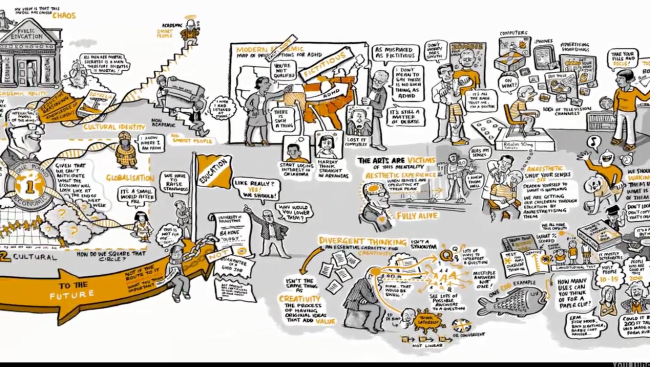
I decided to watch Ken Robinson’s TED talk titled, “Changing Education Paradigms” based on high praise from a classmates blog. (You can find Robinson’s full speech here as the previous is just a portion of his 55 minute speech). Robinson spoke about three major themes in regards to our current model of education: the negative impact of fewer arts in schools today, ADHD, and drop out rates. What I enjoyed the most from Robinson’s speech was what he had to say about divergent thinking.
A lot of people consider divergent thinking to be synonymous with creativity. Robinson argues that divergent thinking is instead an essential capacity for creativity. Divergent thinking is the ability to see lots of possible answers and interpretations. Edward de Bono, perhaps best known for his book Six Thinking Hats (a process used to think in a more detailed and cohesive way) coined this as lateral thinking. Divergent thinking is a skill that a lot of people lose. Is it because we’re taught through our school that there is only one answer? And often only one correct way to get there? Or is it because the older we get, the less imaginative play we participate in? Or maybe it’s because we aren’t given many opportunities in school to practice and increase our ability to think divergently. Whatever the reason, teachers should encourage divergent thinking whenever possible.
As much as I enjoyed Robinson’s speech, I was discouraged by his laundry list of how education needs to be changed without offering any real solutions (maybe the full speech provides solutions. I didn’t get the opportunity to watch it in its entirity). Robinson talked about how the current model of education was created during different times to reflect those times. The Enlightenment created a compulsory education, free for all, and paid for by taxes. The Industrial Revolution lent the framework for education: separate facilities, separate subjects, and being grouped by age. Robinson said that we must change those paradigms. We must go in the opposite direction of standardization which is attempting to create conformity in education. I’m with you, let’s change education. But how?
No more summer vacation? You’re not going to get a lot of support there. At least not until teachers are paid the professional level salaries that they deserve.
How will we decide what grade children should be in? Take a test? Probably not. Hire individuals to observe students and see what grade they should be in? Are grades even the best solution?
I am totally in favor of integrating scholastic subjects, though. And while we’re at it, bring back the arts. Let’s enthuse our lessons with aesthetics.
I don’t mean to be so negative about Robinson’s suggestions. I actually think that he’s on par with a lot of education’s shortcomings. It just seems like we have a big hill to climb.






